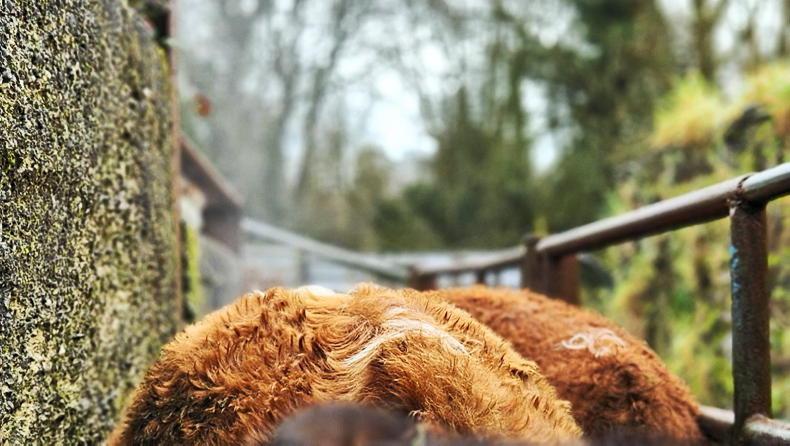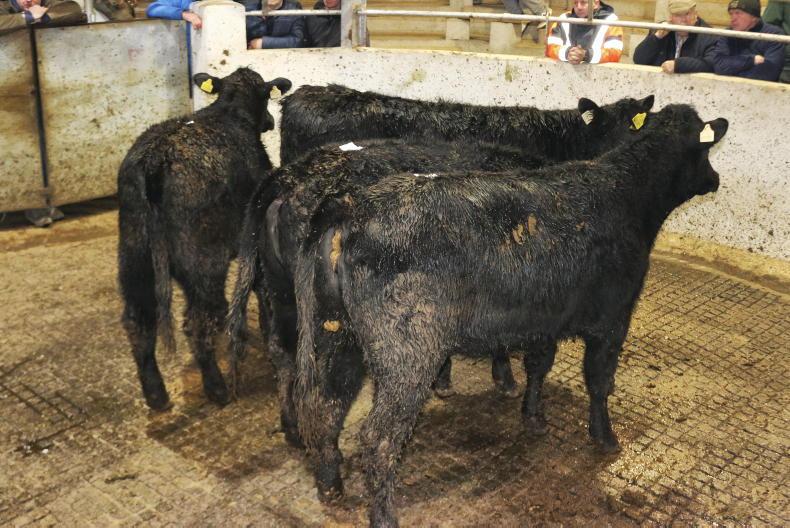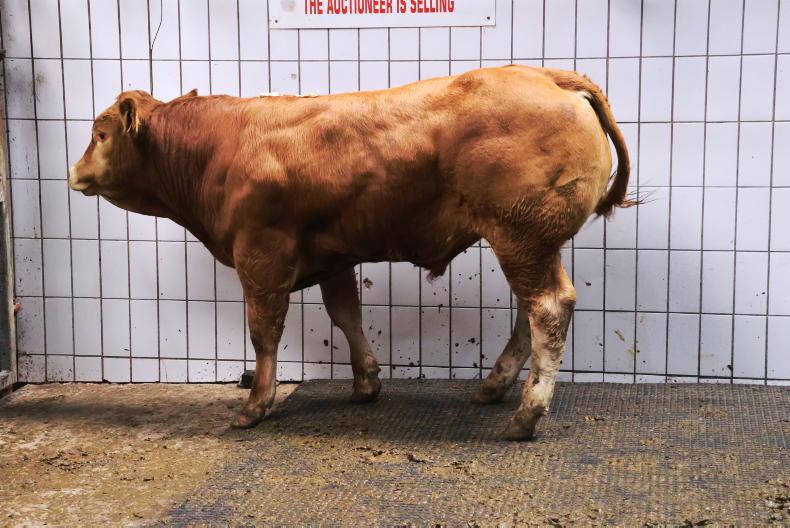Exports of Irish cattle are currently running 3% ahead of 2023 levels and 20% above 2022 levels with weanling and store cattle exports very high compared to last year.
Table 2 outlines the cattle exports for week one to 30 in 2024 compared with the same period in 2023.
Weanling exports are currently running at 23,496 head, up from 19,417 during the same period in 2023 and up from 14,470 for the same period in 2022. This is on the back of big demand from the Middle East and North Africa.
Store cattle have also seen a positive start to 2024 with live exports of store cattle coming in at 21,644 head, up from 16,157 head or 34% on the same period in 2023. Adult cattle are also in demand, with 26,014 exported so far in 2024, up from 20,995 in 2023 or 24%.
There has been a steady trade to Northern Ireland in 2024 with tighter supplies of cattle available for further feeding north of the border supporting a good trade.
A higher beef price has also meant that cull cows and finished cattle have been moving north in the last few months. The trade to Northern Ireland is at a similar level to where it was in 2023.
Some of the big movers include Israel, which has seen a 59% increase in exports on the 2023 numbers.
Morocco has seen a massive increase in weanling and store cattle exports with 7,322 exported so far in 2024, up from zero cattle exported in 2023.
The only blight in the ointment of live exports for 2024 is in relation to calves.
Total calf exports for 2024 are running 4% or almost 8,000 head behind 2023 levels.
This is on the back of reduced demand from the Netherlands, as a result of nitrates pressures on farmers in the Netherlands and a changing veal industry. Further developments in the Netherlands may limit the market post 2025.
One other factor in the reduced exports to the Netherlands has been the lower number of black and white (Holstein Friesian) calves available for sale. Sexed semen has meant a higher number of beef-sired calves available on the market in the form of Aberdeen Angus and Hereford calves.
This has seen increased demand from Spain for Angus-sired calves, in particular, with the exports of calves to Spain up 29% or 15,499 head.
Eastern European markets have also been going really well with good demand from countries like Romania, Croatia and Hungary in 2024, with some very positive feedback on the health of Irish calves from these newly established markets.
Disease restrictions
The outbreak of bluetongue disease across Europe has meant animal movements have been restricted in some countries. This has shifted some cattle buyers to other countries with Irish weanlings being the weanling of choice for many customers who would have traditionally dealt with countries like France, where a lot of bluetongue restrictions on animal movements have been put in place.
It’s not just disease restrictions that are putting Irish weanlings at the top of the shopping list when it comes to purchases.
Ireland has a long tradition of exporting top-quality cattle to countries around the world.
This tradition has built our reputation as a destination for top-quality cattle.
A number of very professional livestock exporters are now operating in the country who have also built up a big reputation for providing top-quality cattle in a streamlined consistent way ticking all the boxes for quarantine and paperwork along the way.
Italian demand
A group of Italian feedlot owners who visited Ireland two weeks ago were highly impressed with the quality of weanlings on offer when visiting Irish farms.
Quality and health were top of their agenda and customers in the group who are already purchasing Irish weanlings highlighted the advantages of the genetics and health in their purchases. They also highlighted some concerns about the future of sourcing top quality weanlings in countries such as France.

A weanling sale at Kilkenny Mart. \ Philip Doyle
They showed a declining suckler herd across Europe as being a major concern on their ability to source the quality they need.
They also talked about a general decline in the passion that some European farmers have in producing top-quality weanlings.
Irish mart managers have expressed concern over the last few weeks with some pointing to a reducing number of top-quality weanlings coming to sales in the last few months.
This, they say, is on the back of a reduction in the number of suckler cows being kept on farms, particularly in the west of Ireland.
It’s a double-edged sword in that the scarcity in the top-quality weanling market has driven the prices up in recent weeks with exporters in particular driving on the prices of the top one-third of weanlings.
This is leading to some shootouts in marts with farmer buyers and exporters facing each other down and pushing weanlings into prices above €4/kg in some cases.
There is also huge competition between exporters for cattle at the moment with a number of Irish exporters competing for the same cattle to fill contracts across Europe and beyond.
Different jobs
It’s not just the top third of weanlings that are in demand with many of the exporters also buying average-quality bulls for different jobs depending on the market. This is a point that mart managers stress as being very important.
Everyone wants the good one but sometimes it’s harder to sell the poorer quality weanling.

This October 2023-born Limousin bull weanling weighed 305kg and sold for €1060 (€3.48/kg) in Elphin Mart last month.
Irish exporters have markets for several grades of cattle, which means that there is a floor being put under the more average-type weanlings.
The fact that between 60% and 70% of weanlings at marts are being purchased for export is a huge positive for Irish farmers, given the prices that exporters are willing to pay at the moment.
It does pose a question, however, as to where it leaves the smaller finisher who normally buys weanlings at this time of year to finish in 2025 or 2026.
The lack of any certainty from factories has meant that many of these farmers are choosing to stay out of the market rather than take the huge risk on a very large investment in buying cattle.
Kill profile
What will that mean for the kill profile in 2025 or 2026?
Will the increasing dominance of the dairy herd on the national kill see carcase weights take another tumble in 2025 and what are the implications for factories and, more importantly, farmers.
Irish factories have been shouting about two steaks fitting on a tray for the last 10 years but some are now starting to lean towards smaller carcases posing a problem in the future.
With carcase weights dropping, will they fit three striploins on a tray or could slaughtering suckler stock be incentivised in the future to keep more of our top cattle in the country?
Live cattle exports are running 3% ahead of 2023 levels.Bluetongue restrictions across Europe mean that Irish cattle are being sought for Middle Eastern and North African contracts.Exports of calves to the Netherlands have dropped by 27% in 2024.
Exports of Irish cattle are currently running 3% ahead of 2023 levels and 20% above 2022 levels with weanling and store cattle exports very high compared to last year.
Table 2 outlines the cattle exports for week one to 30 in 2024 compared with the same period in 2023.
Weanling exports are currently running at 23,496 head, up from 19,417 during the same period in 2023 and up from 14,470 for the same period in 2022. This is on the back of big demand from the Middle East and North Africa.
Store cattle have also seen a positive start to 2024 with live exports of store cattle coming in at 21,644 head, up from 16,157 head or 34% on the same period in 2023. Adult cattle are also in demand, with 26,014 exported so far in 2024, up from 20,995 in 2023 or 24%.
There has been a steady trade to Northern Ireland in 2024 with tighter supplies of cattle available for further feeding north of the border supporting a good trade.
A higher beef price has also meant that cull cows and finished cattle have been moving north in the last few months. The trade to Northern Ireland is at a similar level to where it was in 2023.
Some of the big movers include Israel, which has seen a 59% increase in exports on the 2023 numbers.
Morocco has seen a massive increase in weanling and store cattle exports with 7,322 exported so far in 2024, up from zero cattle exported in 2023.
The only blight in the ointment of live exports for 2024 is in relation to calves.
Total calf exports for 2024 are running 4% or almost 8,000 head behind 2023 levels.
This is on the back of reduced demand from the Netherlands, as a result of nitrates pressures on farmers in the Netherlands and a changing veal industry. Further developments in the Netherlands may limit the market post 2025.
One other factor in the reduced exports to the Netherlands has been the lower number of black and white (Holstein Friesian) calves available for sale. Sexed semen has meant a higher number of beef-sired calves available on the market in the form of Aberdeen Angus and Hereford calves.
This has seen increased demand from Spain for Angus-sired calves, in particular, with the exports of calves to Spain up 29% or 15,499 head.
Eastern European markets have also been going really well with good demand from countries like Romania, Croatia and Hungary in 2024, with some very positive feedback on the health of Irish calves from these newly established markets.
Disease restrictions
The outbreak of bluetongue disease across Europe has meant animal movements have been restricted in some countries. This has shifted some cattle buyers to other countries with Irish weanlings being the weanling of choice for many customers who would have traditionally dealt with countries like France, where a lot of bluetongue restrictions on animal movements have been put in place.
It’s not just disease restrictions that are putting Irish weanlings at the top of the shopping list when it comes to purchases.
Ireland has a long tradition of exporting top-quality cattle to countries around the world.
This tradition has built our reputation as a destination for top-quality cattle.
A number of very professional livestock exporters are now operating in the country who have also built up a big reputation for providing top-quality cattle in a streamlined consistent way ticking all the boxes for quarantine and paperwork along the way.
Italian demand
A group of Italian feedlot owners who visited Ireland two weeks ago were highly impressed with the quality of weanlings on offer when visiting Irish farms.
Quality and health were top of their agenda and customers in the group who are already purchasing Irish weanlings highlighted the advantages of the genetics and health in their purchases. They also highlighted some concerns about the future of sourcing top quality weanlings in countries such as France.

A weanling sale at Kilkenny Mart. \ Philip Doyle
They showed a declining suckler herd across Europe as being a major concern on their ability to source the quality they need.
They also talked about a general decline in the passion that some European farmers have in producing top-quality weanlings.
Irish mart managers have expressed concern over the last few weeks with some pointing to a reducing number of top-quality weanlings coming to sales in the last few months.
This, they say, is on the back of a reduction in the number of suckler cows being kept on farms, particularly in the west of Ireland.
It’s a double-edged sword in that the scarcity in the top-quality weanling market has driven the prices up in recent weeks with exporters in particular driving on the prices of the top one-third of weanlings.
This is leading to some shootouts in marts with farmer buyers and exporters facing each other down and pushing weanlings into prices above €4/kg in some cases.
There is also huge competition between exporters for cattle at the moment with a number of Irish exporters competing for the same cattle to fill contracts across Europe and beyond.
Different jobs
It’s not just the top third of weanlings that are in demand with many of the exporters also buying average-quality bulls for different jobs depending on the market. This is a point that mart managers stress as being very important.
Everyone wants the good one but sometimes it’s harder to sell the poorer quality weanling.

This October 2023-born Limousin bull weanling weighed 305kg and sold for €1060 (€3.48/kg) in Elphin Mart last month.
Irish exporters have markets for several grades of cattle, which means that there is a floor being put under the more average-type weanlings.
The fact that between 60% and 70% of weanlings at marts are being purchased for export is a huge positive for Irish farmers, given the prices that exporters are willing to pay at the moment.
It does pose a question, however, as to where it leaves the smaller finisher who normally buys weanlings at this time of year to finish in 2025 or 2026.
The lack of any certainty from factories has meant that many of these farmers are choosing to stay out of the market rather than take the huge risk on a very large investment in buying cattle.
Kill profile
What will that mean for the kill profile in 2025 or 2026?
Will the increasing dominance of the dairy herd on the national kill see carcase weights take another tumble in 2025 and what are the implications for factories and, more importantly, farmers.
Irish factories have been shouting about two steaks fitting on a tray for the last 10 years but some are now starting to lean towards smaller carcases posing a problem in the future.
With carcase weights dropping, will they fit three striploins on a tray or could slaughtering suckler stock be incentivised in the future to keep more of our top cattle in the country?
Live cattle exports are running 3% ahead of 2023 levels.Bluetongue restrictions across Europe mean that Irish cattle are being sought for Middle Eastern and North African contracts.Exports of calves to the Netherlands have dropped by 27% in 2024.












SHARING OPTIONS